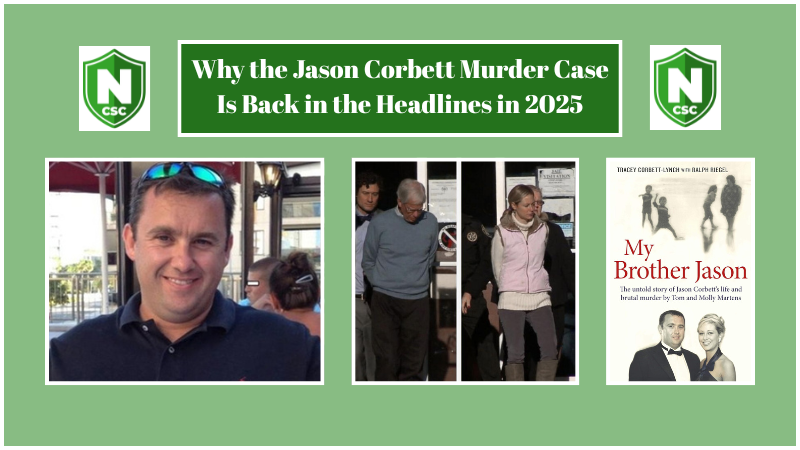Andrew Lackey: A Story of an Alabamian Halloween Killer
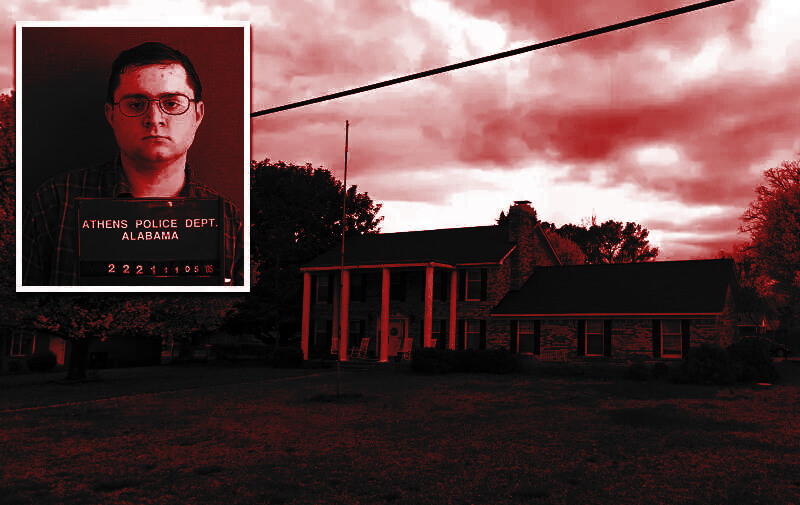
Andrew Lackey, a state native, was a 29-year-old that raised concerns to the people of Alabama, especially residents of Limestone County. On Halloween night, October 31, 2005, Lackey robbed and violently murdered US veteran Charles Newman at his home in Athens, AL. He was on the run for hours after the assault. Lackey was indicted with four charges, including murder during a burglary, capital murder during a robbery, burglary, and robbery. He was executed via lethal injection on 25th July 2013 at around 6:20pm.
It had been around two years since the state of Alabama made national headlines for executing an inmate via lethal injection. The descriptive local media coverage and method of execution sent ripples of debates throughout the rest of the country. In fact, the execution had been delayed several times prior due to concerns of the drugs being used and many had forgotten. Debates about capital punishment were brought up again on the news and social media.
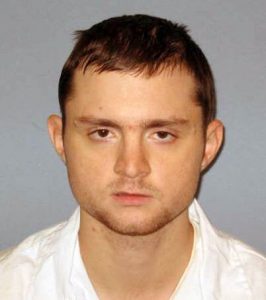
Photo of Andrew Reid Lackey pictured in March 18, 2009. (AP Photo, ALABAMA DEPT. OF CORRECTIONS)
Who was Andrew Lackey?
Andrew Reid Lackey was born to Michael and Sharon Lackey on October 29, 1983 in Alabama. His family described him as living in “Andrew Land” since he was an infant and many friends regarded him as quiet and introverted. His mother Sharon Lackey testified that she knew something wasn’t quite right with her son when he nearly starved himself to death as an infant because he would refuse to breastfeed. Their then pediatrician noted he “failed to thrive” and recommended bottled formula to keep him alive. He only drank from the bottle if he was facing away from his mother.
He was ambidextrous growing up which attracted concerns from a new physician that suspected he was taxing both sides of his brain too much. The physician suggested computer games that would help him choose whether to use his right or left hand. At 5, he spent most of his time to himself and eventually conquered all available Atari games. His aunt testified that he was passive and non violent, but very asocial in that he would face the wall whenever someone entered the room.
A psychologist testified that the assailant had an average IQ and could identify right from wrong but displayed potential signs of either Autism or Asperger’s Syndrome.
He had been a friend of victim Newman’s grandson, Derrick Newman, since the fourth grade. Derrick purportedly told him that his grandfather was “mean and rich” and stashed cash and gold bars in his vault. His mother testified that her son had been manipulated by Derrick to buy him car parts using money Andrew earned as an eBay seller.
The “Mean and Rich” Grandfather
Charles Newman was a retired building contractor who had previously served as a paratrooper in World War II with the 101st Airborne Division and participated in the Operation Overload, D-Day invasion at Normandy, France. Born in 1925, Newman met his untimely death at the hands of his assailant at the age of 80, when he tried to defend himself against the acts of robbery with violence meted to him by his killer, who was also a friend to his grandson.
The Night of the Halloween Killing
Tragically, October 31, 2005 was the last Halloween Charles Newman would ever see. The 80-year-old veteran paratrooper had just put on pajamas did not anticipate what was to come calling that night. Andrew Lackey broke into Newman’s house and Newman promptly called 911. On the recording, he can be heard repeatedly demanding “Where’s the vault? Where’s the vault?” He had information from Newman’s grandson that he was “a multimillionaire” that was hoarding cash and gold bars in a house vault.
After refusing to yield, Newman promptly grabbed his gun and shot him. Lackey then stabbed him with a knife over 70 times and left the blade’s tip in Newman’s skull. He then grabbed Newman’s gun and shot him in the chest. Detectives arrived at the house only to find the lifeless body of Charles Newman on the floor between a couch and a green chair with a large puddle of blood.
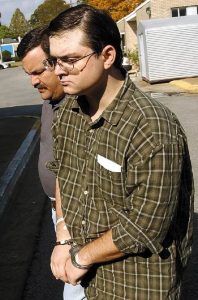
Lackey detained by Athens police Capt. Marty Bruce. (Athens County Jail, November 5, 2005).
The Aftermath
Lackey drove off from the crime scene to rush himself to the hospital, but had to stop at a Chevron gasoline station due to the gunshot injuries sustained and phoned the police. He was arrested and received medical treatment for his wounds, but declined to disclose the cause of his gunshots. The police retrieved a 0.38 caliber Rossi handgun registered to Lackey. DNA matched blood in Newman’s house to Andrew, who got arraigned before a Limestone County jury that recommended the death penalty.
An initial psychiatric report supported that the assailant had Asperger’s syndrome, a form of autism that the prison’s staff noticed and treated at the infirmary. Andrew attempted suicide, which failed, and afterward asked the state to execute him. He became the first inmate to be executed in Alabama since Christopher Johnson on October 20, 2011.
Newman’s home at 611 Hine Street North was professionally cleaned and remediated. The property was last sold in 2014, almost a decade after the incident. No reports of location hauntings have been reported.

Inside the former home of Charles Newman, resident of 611 Hine Street North in Athens, AL.
Andrew Lackey’s Execution
On 25th July 2013 at around 6pm, curtains were lifted in Holman Correctional Facility’s death row to reveal a young, dark haired, Caucasian man wearing glasses, strapped to a gurney. The young man, known to the community as “the Halloween Killer”, lifted his head briefly to look around the room. He resumed resting his head on the pillow attached at the top of his gurney as his execution order was read by the warden of the Holman Correctional Facility. He was then asked if he had anything to say. He did not. His mother, father, brother, and aunt watched his execution along with a man and two women of the victim’s family. A prison Chaplain knelt down in front of him and prayed for him.
Lethal drugs were administered around 6:10pm. A few minutes later his chest and abdomen convulsed and his breathing went shallow. Eventually, his body laid still and by 6:25pm, he was pronounced dead.
How did his execution make national headlines?
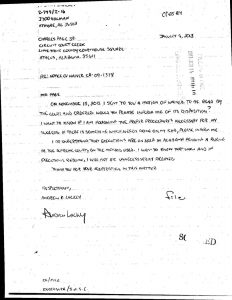
One of the many letters Andrew Lackey wrote to the court clerks requesting the expedition of his death sentence.
For two years executions in the state slowed over pharmaceutical companies opposing the use of their products. The jail also faced issues with assailants remaining alive, unconscious, or choking during the process. At times the injection process would take up to two and a half hours, like the case of Doyle Lee Hamm, where correctional officers could not locate the assailant’s vein due to lifelong intravenous drug use. These reasons are what spurred the Alabama Department of Corrections to construct a gas chamber within Holman. As of 2021, executions are carried out via nitrogen hypoxia.
The Holman Correctional Facility in Atmore, Alabama had executed 69 men and 1 woman via lethal injection since 2002. The facility is one of many that have raised concerns and controversy over the frequency and types of lethal drugs used. In 2021, 28 out of the 29 states that authorize capital punishment use lethal injection as the primary method, Alabama included.
It makes sense that Lackey’s case had been delayed, though the controversy over the death penalty is another topic entirely. It is a known fact he was depressed and troubled, even experiencing a failed suicide attempt while in prison. He was in support of his fate, he even wrote to the court to prevent the further delay of his sentence. After his prison suicide attempt in 2012, he wrote to the court:
Hello. My name is Andrew Lackey. I wish to drop my Batson issue and not appeal my death sentence. Please get in touch with me.
He continued to write to the Equal Justice Initiative and state court counsels that year:
I thank you for you work on my behalf, but your efforts do not match my desires in this matter. I have tried to make my wishes clear in the past. I do not desire your services any further and your representation is hereby terminated. Do not file anything further on my behalf.
Did the system provide justice, cease Andrew’s suffering, or not provide the right support? That interpretation is up to you. What is known for sure is that his execution certainly resurfaced the debate, controversy, and confusion on what capital punishment should be, if at all.
Where do you stand? Discuss by sharing this post on Facebook or Twitter!
References
https://en.wikipedia.org/wiki/List_of_people_executed_in_Alabama
https://www.al.com/wire/2013/07/four_family_members_visit_andr.html
https://ssristories.org/andrew-reid-lackey-v-state-of-alabama-court-of-criminal-appeals-of-alabama/
https://oddstops.com/location.php?id=207
Hungering for more true crime? Take a look at the famous murders that changed America or other murders that changed Halloween forever.


